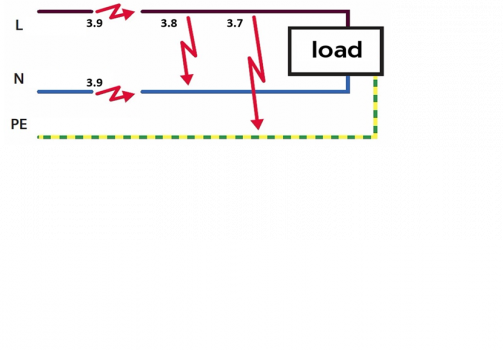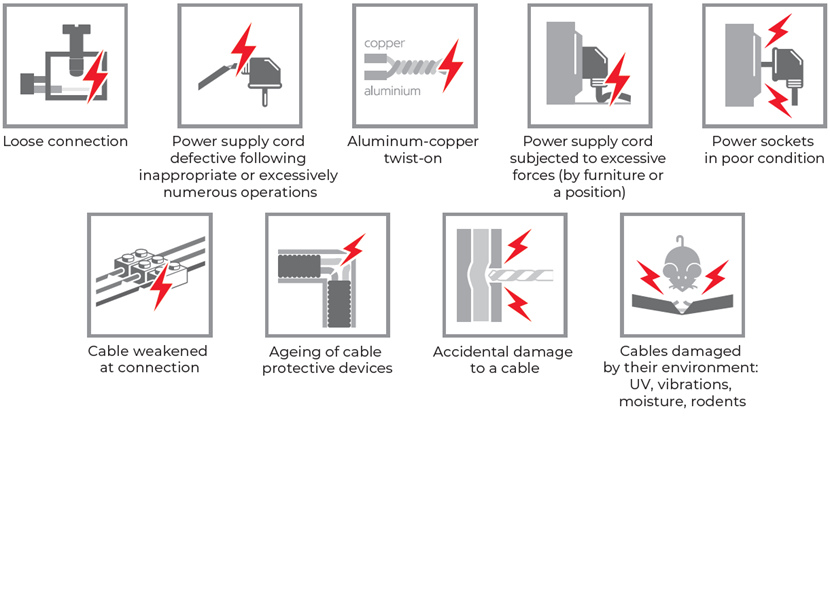1.What is an AFDD and what does it do?
Answer. According to standard IEC 62606, an AFDD
is an Arc Fault Detection Device and it is designed to detect the presence of dangerous electrical arcs and
disconnect the circuit affected.
2.Why do we need AFDD, if miniature circuit breakers (MCB)
and residual current device (RCD) are already used?
Answer. MCB and RCD do not protect the circuit
from arc breakdowns. For example, loose connection at some point in the current-carrying path, leading to an
arc breakdown, increases the overall resistance of the circuit. So, the current in the circuit decreases. As
a result, MCB will not trip off in this case. There is no leakage of current to the ground, so the RCD does
not react either. AFDD is the 3rd stage of protection of electrical circuits together with MCB and RCD.
3.Is sparking a common cause of fires?
Answer. Yes, that's right. The share of fires
due to the emergency operation of electrical circuits and appliances increases from year to year. Over the
past 10 years, this share has increased from 22% to 32%

- the death toll increased from 14% to 24%
- the share of direct material losses increased from 29% to 40%
- Source: The Ministry of the Russian Federation for Civil Defence, Emergencies and Elimination of
Consequences of Natural Disasters (EMERCOM of Russia).
4.Situation increasing risks of fire.
5.What standard does AFDD meet and what analogues
of this standard are there all over the world?
Answer. All necessary information on
AGDDs is included at IEC 62606-2016 (General requirements for arc fault detection devices) standard.
A similar standard GOST IEC 62606-2016 was approved for Russia on May 23, 2017. The standard is also
applied in European regional and national forms (DIN EN, VDE, etc.).
6.What kind of arc breakdown does IEC 62606-2016
take into account?
Answer. The following subsections
(3.7-3.9) of the standard should be considered. 3.7 Earth arc fault: arc fault where the current is
flowing from active conductor to the earth. 3.8 Parallel arc fault: arc fault where the arc current
is flowing between active conductors in parallel with the load of 3.9 Series arc fault): arc fault
where the current is flowing through the load(s) of the final circuit protected by an AFDD.

7.What area is AFDD designed for? How many AFDDs
do I need to install to protect the apartment?
Answer. The only AFDD TUMOV protects an
apartment with an area of 120-150 sq. m. (with an average saturation of various electrical
appliances). Each phase must be equipped with its own AFDD.
8.Why does the supply voltage not restore
automatically after tripping off?
Answer. Subsection 8.2.2 of IEC
62606-2016 contain the following: “AFDDs shall have a trip-free mechanism”. This means
the automatic switching on of the supply voltage should be excluded. Manual activation is allowed
only which is implemented in the device. AFDDs with manual recovery are manufactured by European and
North American vendors, automatic activation is prohibited by the standard.
9.Why does AFDD not have a low-voltage shutdown
function??
Answer. This correlates with a trip-free
mechanism as well (see point 8) and manual activation. Some electric networks do not have stability,
the power supply can be turned off often and for some time. The user will have to turn on AFDD
manually after each power outage, but this will be annoying. A low-voltage shutdown function is not
implemented for devices of other vendors as well.
10.Why is the device powered only from one side
and from the bottom?
Answer. This is a design feature. The
matter it that a trip-free mechanism is not symmetrical in the vertical direction. AFDDs shall be
designed so that the actuator, front plate or cover can only be fitted in a manner which ensures
correct indication of the contact position. This feature is typical for other vendors as well:
Siemens, Eaton, Schrack.
11.Will the device trip off from arcing in the
circuit at the input terminals or from arcing at the neighbors?
Answer. No, it won't trip off. AFDD
is tripped off due to arcing ONLY in the protected circuit.
12.I would like to get more details about the
principle of operation — how does AFDD understand that arcing occurs, what criteria are being
considered?
Answer. The set of circuit parameters
(current and voltage of the of arcing) is analyzed. An AFDD shall clear the arcing fault if the
number of half-cycles of arcing occurs within a period of 0,5 s. For the purposes of these
requirements, an arcing half-cycle is considered to be all of the current traces occurring within a
period of 10 ms for a device rated 50 Hz and 8,3 ms for a device rated 60 Hz. Within that time
period there may be current flow for some but not all of the time. Prior to and following each
period of current flow, there may be a period with no current or very reduced current. Very reduced
current is considered to be current with amplitude less than 5 % of the available current or current
that continues for not more than 5 % of the duration of half-cycle. This may last for either a
portion of a half cycle or for several half cycles. A complete sinusoidal half cycle of current flow
is not considered to be an arcing half cycle. At a certain value, shape, polarity, time and rate of
these jumps, the automation of the device decides to trip off the protected circuit.
13.Does AFDD protect the connected circuit from
pulsed voltage surges?
Answer. Yes, the varistor is located at
the input of the device. The parameters of the varistor protection are given in the Operating
Manual.
14.Some AFDDs have both MCB and RCD in their case,
but the AFDD TUMOV does not have one. Which option meets the standard?
Answer. Both types correspond. The
standard prescribes 3 types of AFDD design: 1) with a trip-free mechanism, both MCB and RCD are not
included (this is how AFDD TUMOV is made); 2) MCB and/or RCD and arc detector are placed in one
body; 3) MCB and/or RCD trips off by arc fault detection device block mechanically. All devices can
be assembled into a single body at the installation site.
15.What is the mains voltage measured by AFDD
TUMOV – average rectified, RMS, peak?
Answer. True RMS (Root-mean-square).
16.Why do I need Test Unit (TU)? Devices of other
vendors do not have such equipment.
Answer. This service function is optional and provided by Ecolight Ltd. The main purpose of TU is
to determine the real operation area of AFDD at the place of its installation. Plugged into an
outlet or directly to AFDD TUMOV, TU produces arcing signs perceived by the AFDD with the lowest
arcing current value to be detected according to IEC 62606 standard, those, current 2.5 A for
voltage 230 V. The second TU function is to check the serviceability of AFDD TUMOV. The check
can be implemented either through any outlet, or directly at AFDD TUMOV terminals.
17.TU is plugged into the outlet, but AFDD TUMOV
does not trip off. What should be done?
Answer. Ways to fix the issue:
- Make sure the outlet is connected to the protected line.
- Get more info about the increase in operating area from Operating manual
- Install an additional AFDD by dividing the protected circuit in parallel or in series.
18.How can I make sure AFDD really protects the
entire circuit connected through it?
Answer. As to AFDD TUMOV, TU can be used
(see point 16). There is no information for devices of other vendors. A physical arc test can be
carried out.
19.How is the serviceability of AFDD checked?
Answer. Both manual (with a button) and
automatic diagnostics, and both together can be carried out according to IEC 62606-2016 standard.
AFDD TUMOV uses automatic self-test, which is carried out, according to the standard, after each
switch-on and then at least once a day. In addition, the actual AFDD TUMOV serviceability can be
checked at any time by TU (see point 16). The serviceability check of other vendors AFDDs is
performed according to their documentation.
20.Can TU (Test Unit) be used to check AFDD by
other vendors?
Answer. No, you can't Devices by
other vendors may not tripped with it Spark detection algorithms differ from vendor to vendor. A
real arc generator can become a general tester, but this is not a cheap and cumbersome thing.
21.What appliances AFDD TUMOV compatible with??
Answer. A large number of experiments
were carried out. In addition, tests under subsection 9.9 (IEC 62606-2016 standard), which includes
7 different kinds of equipment, were also carried out. The zero level of false positives is
provided. Long-term tests in offices and residential buildings were also carried out. The zero level
of false positives is provided.
22.Regulatory framework for the use of AFDD.
A. IEC 62606-2016. This International
Standard applies to arc fault detection devices (AFDD) for household and similar uses
23.AFDD TUMOV competitive advantages
- Made in Russia!
- Reliable detection of arcing (arc breakdown) is provided by a multi-factor and
multi-stage algorithm:
- in distributed circuits;
- in a circuit with a high-power load, the current in the circuit is up to 63 A;
a single device for each phase is enough for a house or apartment with an area of up to 150
sq.m.;
- zero level of false positives.
Re-enabling to determine the cause of the tripping is not required.
- Independent external TEST UNIT (TU) to determine the real operation area and monitoring
the operability
- An additional function is an overvoltage shutdown threshold
- Competitive price



